|


|

NEWS: January-Jnne 2020
|
|
June 30, 2020 |
|
Last fall Minnesota native Jessica Lange published her
third collection of black and white photographs called "Highway 61" which
were also exhibited at Howard Greenberg's NYC gallery.
Highway 61 originates in the city of Wyoming, Minnesota running 1400 miles along
the Mississippi River all the way down to New Orleans.
She dedicated both the book and exhibit to Sam and when Rolling Stone
asked her about the dedication last October, she replied, "Yeah. (Long pause) I
miss him every single day of my life, and I thought, 'Well, this would be a good
dedication because there was a man who loved the road and spent a good portion
of his life driving different highways.' So, yeah." (Smiles)
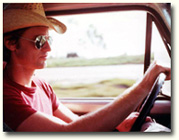
I believe this was the first time that Ms. Lange spoke
publicly about Sam since his death three years ago. Why she never did remains a
mystery as well as why she didn't join the family at his bedside where he lay
dying. At least ex-girlfriend Patty Smith loved him enough to care for him in
his final weeks.
Another film page added! As most Shepard fans know, the
married Sam and the beautiful actress became an item while filming "Frances" so
it wasn't surprising that he would be considered for the role of Gil Ivy in a film called
COUNTRY that she was about to co-produce and star in. It was a project that
concerned Ms. Lange at that time. She told the press, "The part of Jewel Ivy was
more familiar to me than any other part I've played. I drew from all my aunts in
rural Minnesota. I wanted to convey the tremendous strength and tenacity of
these women in balance with a heartbreaking vulnerability."
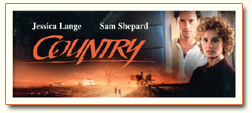
"Country" was the story of the trials and tribulations of a
rural family as they struggled to hold on to their farm during the trying
economic times experienced by family farms in the 1980s. Coincidentally, there
were three movies released in 1984 with stories about the farmers' plight told
from the perspective of a strong heroine. Remember Sissy Spacek in "The River"
and Sally Field in "Places in the Heart"?
It was a troubled project from the beginning. The script by
Austin's William D. Wittliff was rejected by most Hollywood studios and when
production began in late 1983, Wittliff, who was set to also direct, resigned
three weeks into filming after his differences with Lange and Shepard proved
insurmountable. Richard Pearce took over the cold and difficult
winter shoot in Iowa. In the end, Sam did contribute to the screenplay though
his name does not appear among the credit titles.
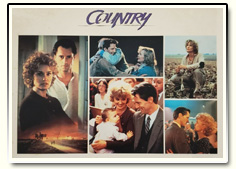
During filming, Sam continued to write to his pal Johnny Dark
and there are two interesting excerpts I'd like to share. The first one was
written in October 1983 in which Sam discusses his frustration with the
production.
"Well, a lot of shit has hit the fan since I started this
letter 10 days ago. The cinematographer has been fired, the director's quit &
I've quit until they get a replacement. They've threatened to sue me if I don't
go back to work but threats always make me more stubborn. It's a strange
situation to be in because Jessica has a big stake in this film & she wants to
get it done come hell or high water. At this point I just want to go back home &
ride my horses & shoot my new shotgun & maybe build a fire in the fireplace. I
really can't stand this movie crap anymore - it gets harder & harder to do it."
"I don't really know what's going to happen now. The
producers are frantically looking for a new director & trying to keep the film
rolling so they don't lose money. I suppose this move on my part is going to
brand me as 'difficult' & 'temperamental' in Tinsel Town. I really don't give a
shit anymore. Jessie & me are closer than ever but life in the movies is just
not my game so I guess I'll just have to accept this fact that I'm hooked up
with a movie star & allow her to play that out & maybe just ride along beside
her on the sidelines somehow."
This would be Sam's 8th film and though he describes his
disdain for movie making, he did go on to make 50 more films! The second
excerpt is from a December 10, 1983 letter in which he professes his love for
Ms. Lange.
"I wanted to give her a ring & ask her in the corniest way
possible if she'd be my wife and have my kids and live with me forever. I bought
this great Sapphire ring set in gold. I stuffed it in my pocket & got all
excited about asking her. I waited for her to come into the motel where we watch
the dailies every afternoon & when I saw her coming, I swept her outside into
the cold wind and snow & popped the question. We jumped up and down together
like little kids, giggling in the snow."
Obviously, the marriage never happened and perhaps that was
the right decision for Sam since he had a problem staying faithful to any woman.
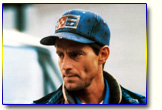 What
some critics pointed out in their movie reviews was
that Sam was definitely miscast and I agree with them wholeheartedly. One critic
wrote, "The husband is basically a weak man, unable to hold up to
pressure. Shepard doesn't look like he has a weak bone in his body. It's a
little like casting John Wayne as a coward." Texas Monthly wrote, "As
Jewell's husband Gil, Shepard flashes a wolfish grin at the beginning and is
sneakily appealing, but as the farm slips away, Gil turns into a bitter, moist
weakling. Sam Shepard wasn't born to play weaklings - his bones were built for
heroism". And from the Daily Titan - "Shepard, the playwright-actor, who
has been hailed as a modern Gary Cooper, is hopelessly miscast as the suddenly
spineless Gil Ivy." Certainly his conversion from devoted husband to petulant
and abusive drunk is too extreme and results in a confused audience in defining
his character. What
some critics pointed out in their movie reviews was
that Sam was definitely miscast and I agree with them wholeheartedly. One critic
wrote, "The husband is basically a weak man, unable to hold up to
pressure. Shepard doesn't look like he has a weak bone in his body. It's a
little like casting John Wayne as a coward." Texas Monthly wrote, "As
Jewell's husband Gil, Shepard flashes a wolfish grin at the beginning and is
sneakily appealing, but as the farm slips away, Gil turns into a bitter, moist
weakling. Sam Shepard wasn't born to play weaklings - his bones were built for
heroism". And from the Daily Titan - "Shepard, the playwright-actor, who
has been hailed as a modern Gary Cooper, is hopelessly miscast as the suddenly
spineless Gil Ivy." Certainly his conversion from devoted husband to petulant
and abusive drunk is too extreme and results in a confused audience in defining
his character.
Although the film failed at the box office, it was
generally admired by critics. Ms. Lange
was nominated for both an Oscar and Golden Globe "Best Actress" award for her
performance. She also joined Sissy Spacek and Jane Fonda in testifying before
the United States Congress about the traumatic conditions of America’s
heartland. The film also caught the attention of then-president Ronald
Reagan, who decried the supposed propaganda of the picture even though part of
its provocation also stemmed from the prior policies of Jimmy Carter. |
|
|
|
June 25, 2020 |
|
It was the second time for Sam to sit in the film director's
chair in the spring of 1992 as he began production for his screenplay called
SILENT TONGUE. For the film's location, he
chose the desolate landscape on the plains of southeastern New Mexico - Llano
Estacado, or Staked Plains. His story, a bizarre combination of western film
revisionism and Greek tragedy, takes place in 1873. He described his chosen
location - "This was probably the most terrifying piece of real estate west of
the Mississippi. It was absolutely scary. It's a flat table of land with no
vegetation at all except burned-out mesquite and cactus. It's wide open. In
order to cross it, you were totally exposed to these raids that were pretty
persistent up until the Texas Rangers came in."
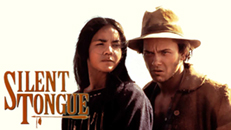
Inspired by the 1954 western bestseller "The Searchers" by
Alan LeMay and John Ford's 1956 screen adaptation, Sam wrote "Silent Tongue" in
just 10 days, revised it half a dozen times, then handed it out replete with
camera directions and location sites. The script was initially rejected due to
its lack of commercial appeal. Sam opined - "Two years later an Indian film wins
the Academy Award ("Dances With Wolves") and a ghost film ("Ghost") is number
one at the box office. That was kind of an odd twist of fate."
In no way does this screenplay come close to the overwhelmingly positive
reception of those two cleverly-crafted films.
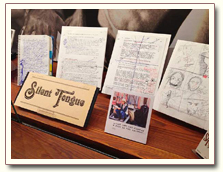
The photo above is from the Wittliff Collection showing Sam's
scribbling and sketches. Certainly, his first failed attempt as a film
director/writer with "Far North" didn't help. However, he had his own take -
"The biggest difference between that film and this one is I didn't shoot enough
footage with 'Far North.' I just didn't have enough material for that one. When
I sat down to cut it, I was forced to get stock footage, which was an awful
predicament. I'm shooting a lot more on this one and printing a lot, a lot more
angles and coverage."
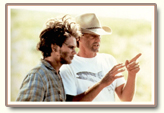
He also told the press, "Directing feels great; I'm really happy to be doing
this. It's rough going, we're working our butts off, we're doing 40 set-ups a
day, but it's still better than working in a bank or cleaning horse stalls."
The cast of "Silent Tongue" was obviously impressive starting
with the theater and film talent of Irish actor Richard Harris and British actor
Alan Bates. Then, add Dermot Mulroney and River Phoenix. Since Sam had just
finished "Thunderheart", he also gave a major role to his co-star, Native
American Sheila Tousey. It is important to note that this was River's last film
to be released after he died from a tragic drug overdose on October 31, 1993.
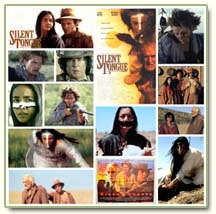
This tale of revenge and mysticism is grounded in all the
familiar Shepardian themes - dysfunctional families, painful father/son
relationships, insanity, horses, alcoholism, and buried secrets that fester. Sam
explained, "I think it has more to do with 'lostness' than anything else."
"Silent Tongue" takes its plot from the attempt of a distraught Irish-American
youth, played by River Phoenix, to guard the corpse of his half-Kiowa wife. His
vigil leads to a battle with her vengeful Indian ghost, and destroys what
semblance of peace existed in both their families.
Financing for the film was a bit odd for a western. It was an
entirely French-financed American production. Belbo Films, based in France,
successfully orchestrated funding for the $8.5-million independent production
from StudioCanal and Hachette Premiere. But, the French do adore Sam Shepard!
When the film was released in France, it was called "Le gardien des esprits".
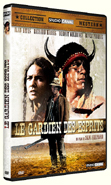
An early version of the film premiered on January 28, 1993 at
the Sundance Film Festival. The photo below shows Sam at the Egyptian Theatre
where he took questions after the screening. The film did not receive a warm
reception.
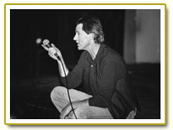
He edited it considerably and it later went on to screen that
year in November at both the London Film Festival and Native American Film
Festival. It lacked a distributor until February 1994 when it was released in
the US to mostly negative reviews. It was the last film that Sam ever directed.
At this time in 1992 while filming, Sam still didn't
have his Directors Guild card but he admitted, "I've always found it
embarrassing to receive awards. I'm really genuinely not doing it for
achievement anymore. It might have been the case when I was 19, but it's so
different now than it was then."
At this time, motivated by writers, such as Vladimir Nabokov,
Pablo Neruda, Samuel Beckett, Peter Handke and Jim Harrison, Sam was about to
focus on storytelling - "I absolutely think that there's a level of storytelling
just around the corner that you can tap into, that I'm really interested in now.
I can't explain it very clearly but it's different from anything I've ever done
before. I used to think it was about images and visions. Now I'm convinced it's
about storytelling, storytelling for the purpose of the human deal and not
dragging people down, for supporting the fact of persisting and going on." |
|
|
|
June 19, 2020 |
|
In 1977 the Magic Theatre had moved from its Berkeley
storefront into a new home in a Fort Mason warehouse. The new theater would be
inaugurated with Sam’s latest work.
On a $15,000 grant from the Rockefeller Foundation, he spent six weeks with
eight actors and eight musicians developing an improvisational jazz opera called
INACOMA. It was like nothing Sam wrote
before or afterward, the exploration of the twilight psyche of Karen Ann
Quinlan, a young woman who triggered an early "right to die" controversy after
falling into a long coma.
Shepard was intrigued by this story - identity and destiny.
"At first," he explained, "All I could visualize was a hospital bed, the coma
victim and creature-characters. Then various scenes would start popping up, all
out of context and wandering in and out of different realities. The scenes were
joined by sounds of breathing, then music, then back to sounds. I kept
abandoning the idea of even starting to write something because the subject
became too vast and uncontrollable."
This photo shows Sam in February 1977 in rehearsal.
The play
opened on March 18, 1977 with six weeks of performances.
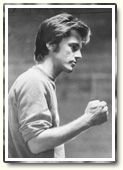
Theater critic Misha Berson was fresh out of college at that
time working as the performing arts coordinator at Fort Mason and took every
excuse to nose around the rehearsals. She reminisces, "Except for
the song lyrics, I recall the piece as largely nonverbal and probably as close
to performance art as anything Shepard ever authored. I discreetly watched from
the unfinished bleacher seating as he developed the piece, intently focused on
his intrepid cast (which included his gifted then-wife, O-Lan Shepard),
conferring with them in a soft reedy voice tinged with twang."
"Reflecting the eclectic theatrical inventions bubbling up in
San Francisco back then, 'Inacoma' emerged from movement and musical
improvisations, yielding images of spinning orderlies in white jumpsuits and a
Quinlan-like character who rose from her hospital bed to dance. What I gleaned
from that now-obscure production was that Shepard was a true seeker and
experimentalist, an artistic stretcher and prober, forever scouting for not just
his literary voice but his voices."
Berson also adds,
"Wearing leather jacket, blue jeans, and shades, his dark hair flopping over his
forehead, Sam was so cool he could've been an extra from the iconic hipster film
'Easy Rider'. But in the late 1970s he was already famous in his own right, at
least among theater folk, for his cowboy-beatnik charisma and his sui generis,
rock-the-genre plays."
The play didn’t become one of Sam’s most important works.
Chronicle theater critic Bernard Weiner interviewed Sam and described the
show as beginning with a series of visual images in the author’s mind, and
developing out of improvisational work with the actors and musicians.
"Many of my plays center around a character in a critical state of
consciousness. I like to operate off that dynamic," Sam said. "The comatose
state is especially fascinating because, from the outside, nobody really knows
what’s going on inside the person in the coma."
The play featured veteran Magic Theatre actors James Dean, Ann Matthews, O-lan
Shepard, John Nesci, Fred Ward, Sigrid Wurdchmidt and Jane Dornacker, most of
whom had been in his San-Francisco-produced plays.
San Francisco was a welcome fit for the playwright's creativity. "After years of
struggling to find an audience in New York, it's nice to find people here and in
London finally catch on to what you’re doing," Sam said. "It’s been good here.
There’s more freedom to experiment, to breathe."
As an aside, Christopher Arnott of the Hartford Courant noted
this observation on Sam's death in 2017 - "One mark of how influential Shepard
was beyond the traditional boundaries of American theater is the number of
contemporary rock bands that have been named after his plays. These include
Savage Love, True West, Inacoma and, yes, Cowboy Mouth and Buried
Child... Sam Shepard's not dead. He rocks on." * * * * *
As a kid, Sam had gone by the name "Steve Rogers" to distinguish himself
from his father.
In 1963 at the age of 20, Sam decided to re-invent himself by changing his given
name. He said, "I always thought Rogers was a corny name because
of Roy Rogers and all the associations with that. But Samuel Shepard Rogers was
kind of a long handle. So I just dropped the Rogers part of it... Now in a way I
kind of regret it. But it was, you know, one of those reactions to your
background. Years later, I found out that Steve Rogers was the original name of
Captain America in the comics." |
|
|
|
June 9, 2020 |
|
Some critics consider true "True West" to be the third in a
trilogy including "Curse of the Starving Class" and "Buried Child", while others
consider it part of a quintet which includes "Fool for Love" and "A Lie of the
Mind". The play was a finalist for the Pulitzer Prize for Drama in 1983 and it
hasn't left the theatrical landscape since it first premiered with Peter Coyote
at San Francisco's Magic Theater in 1980. Chicago's Steppenwolf Theatre's 1982
production with John Malkovich and Gary Sinise remains legendary and its
popularity continues with Broadway's outing with Ethan Hawke and Paul Dano
staged
seventeen months ago at the Roundabout Theatre.
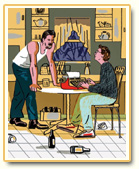
Set in 1980 in an out-of-the-way Southern California suburb, it remains a
visceral look at played-out Wild West stereotypes, familial envy and revenge,
and false value surfacing as Hollywood cliches. Today I've updated the TRUE WEST page with
more information and photos. Though I had seen the stage performance with Sinise
and Malkovich on videotape, I hadn't been aware of the that production's
televised airings - first in 1984 on the PBS series - "American Playhouse" and
then in 1998 on "Great Performances". There was also a filmed version of an
Idaho production starring Bruce Willis in 2002 on Showtime.
* * * * *
Here's the cover of a 1985 issue of the Western Writers
series devoted to Sam's plays. The 50-page edition was written by Vivian Patraka
and Mark Siegel and published by Boise State University.
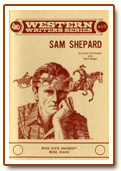
Excerpt:
"Only the avant-garde had taken much notice of Shepard in his early years, and
even those who did write about him seemed to promote him without much exegesis.
However, by the early 1980s Shepard had been virtually canonized by the critical
establishment as the most important and interesting to analyze of contemporary
playwrights. Even when such critical powers of bourgeois culture, they found his
work fascinating and challenging. Elizabeth Hardwick, Susan Sontag, and Ruby
Cohen all championed Shepard against the few conservative figures, such as
Walter Kerr and Tennessee Williams, who still found Shepard an anathema... Again
and again, Shepard has been perceived by critics as both a truly American
playwright and a writer of universal value and distinction, as both 'ruthlessly
experimental and uncompromising' (John Lahr) and as a playwright who deals with
and illuminates traditional American and dramatic concerns." |
|
|
|
June 7, 2020 |
|
Galisteo publisher John Miller created the book "Sam
Shepard; New Mexico" sharing Sam's writing with the photographs of Ed Ruscha.
It was published this past winter. Mr. Miller writes,
Sam Shepard had a deep bond with Santa Fe, where he lived in the 1980s and again
in 2010–2015. But Shepard had some nomad in him, and as he recorded in his Motel
Chronicles in 1982, he spent as much time crisscrossing the deserts of New
Mexico as he did living in any one city. As Shepard’s friend Johnny Dark said,
“He lived in Santa Fe, but he also lived in hotels and on the road. . . . He
might have been running away or he might have been running toward something.”
Twenty years earlier, the artist Ed Ruscha, traveling from Oklahoma to Los
Angeles, traversed New Mexico and created ghostly photographs of New Mexico gas
stations. Together, Shepard’s writing and Ruscha’s images evoke a poetry of
loneliness.
Included in the book are quotes from Bob Dylan, Taylor
Sheridan and Josh Brolin.

You might ask what connection Josh Brolin has to Sam
Shepard and in this moving farewell that Josh shared on Instagram back in July
2017, he answers that question.
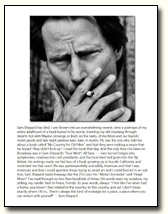
* * * * *
Taos-raised actor, writer, director, producer and poet
Arron Shiver recently mused on life under lockdown in LA. One of his poems
about Sam was published in the spring issue of the Taos Poetry Journal.
Shiver says, "I wrote
that poem 'My Hero' to commemorate one of my theater heroes. If I look back at
the bits of my own writing I'm proud of, and even some of the acting, to be
honest, I can see a direct link to Sam, so it shook me when he passed. I pretty
much had read all of his stuff, and it had a tremendous effect on me. formed me,
in a lot of ways. So when he passed away back in 2017, I was in LA, and we all
sat around drinking tequila and reading his lines out loud, and everything I
remembered about my interactions with him came out. This poem was an offshoot of
that. Stuff I remembered from that time. Funny stuff, mainly. Almost fights, a
lot of drinking, some wonderful advice he gave me about acting. At that time he
usually would rather talk about horses than acting. He had worked hard and he
had worked a long time, and all he really wanted to do by the time I met him, as
far as I could tell, was fish and ride horses."
The first verse reads -
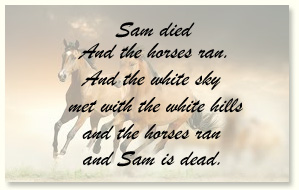
* * * * * DID YOU KNOW that when Warren Beatty was ready to cast "Reds",
Sam was considered for the role of "Eugene O’Neill" before Jack Nicholson was
offered the role. You may remember he played writer Dashiell Hammett in the A&E TV
production "Dash & Lily" in 1999.
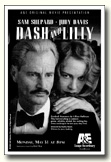
|
|
|
|
May 7, 2020 |
|
 In
the News: Artistic Director Loretta Greco is leaving San Fancisco's Magic
Theatre this month. Americantheatre.org wrote, "Greco says she has loved her
time with Magic. Sam Shepard might be remembered as building the theatre, but
Greco will be remembered for inviting everyone in. Greco had been aware of the
theatre because of Shepard, who she calls 'one of our greatest writers, period,
the end,' and getting to work with him there was a highlight for her. He was
constantly searching, she says, writing for six decades, from when he was a
teenager to a few days before he died in 2017." In
the News: Artistic Director Loretta Greco is leaving San Fancisco's Magic
Theatre this month. Americantheatre.org wrote, "Greco says she has loved her
time with Magic. Sam Shepard might be remembered as building the theatre, but
Greco will be remembered for inviting everyone in. Greco had been aware of the
theatre because of Shepard, who she calls 'one of our greatest writers, period,
the end,' and getting to work with him there was a highlight for her. He was
constantly searching, she says, writing for six decades, from when he was a
teenager to a few days before he died in 2017."
"Greco keeps some of his short stories by her favorite chair
- his work is like a balm for her. 'I was a complete idiot when I first met
him,' she recalls. 'I was so nervous that I drove up Franklin the wrong way with
Sam in the car. It was hilarious because he was calming me down, and I drive
down Franklin every day. It wasn’t a new road for me - it was that I had my hero
next to me.'"
Sam with Greco in 2013:
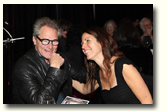
I came across a few other remembrances about Sam
Former Artistic Director Larry Eilenberg:
"Sam Shepard’s relationship to the Magic Theatre now enters the history books
side-by-side with Chekhov and the Moscow Art Theatre, O’Neill and the
Provincetown Players, Odets and the Group Theatre. While in residence during the
1970s and early 80s, here in San Francisco, Sam bridged the gap between American
realism and European absurdism with a voice that was all his own... One of the
things I most admired about working with Sam was his insistence upon the primacy
of the word. And his words will last, I trust, as long as there are actors and
audiences."
Actress Jessi Campbell:
"Sam has broken my heart open a thousand times. It's hard to say exactly what it
is, but it's something about his endless searching, his insatiable hunger, his
inner turmoil, his relentlessness... His broken men and broken-hearted women...
His cowboys, his fathers, his dreamers, his lovers, his love for the open
road... Nothing has taught me more about the beauty and the pain of being human.
His work has transformed me again and again. He is my favorite. Always will be."
Actor Rod Gnapp:
"Working on Sam Shepard's plays at the Magic, have been the most rewarding and
challenging theatrical experiences of my life. My brushes with him and his
plays, have made me grapple with the best and the worst of myself. I feel really
blessed to have crossed paths with him while working on 'The Late Henry Moss';
and been lucky enough to be in the room and watch him do what he loved... Making
theatre out of nothing but his own driven desire. Sam smiling and holding me by
the shoulder as we toasted a whiskey to celebrate the wild ride was a moment I
will always cherish."
Director/writer/performer Sean San
José:
"He made the world so real through his unreal way of approaching it - my whole
head opened up seeing his play and I have never found anything that comes close
to trying to show the world we live in as well as live theatre."
* * * * *
During most of Sam's photo shoots at the 2005 Cannes Film
Festival, he wore sunglasses so these two photos are unique and capture his
extraordinary looks at mid-life.
|
|
|
|
April 16, 2020 |
|
In 1987, an off-Broadway play made waves when a Hollywood
producer saw it and quickly turned it into the movie STEEL MAGNOLIAS. It has
become one of the most beloved movies of all time, cluttered with terrific
one-liners and heartfelt moments. Portraying the six Southern belles were Julia
Roberts, Sally Field, Dolly Parton, Shirley MacLaine, Daryl Hannah and Olympia
Dukakis. They embodied sass, stubbornness, loyalty and a
do-anything-for-a-friend mentality.
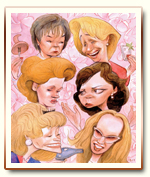
Initial reviews were mixed.
Some critics found it weepy but ultimately winning; others thought the film’s
brassy sentimentality undermined its real emotional impact. And some took issue
with its portrayals of men. Nonetheless, it became 1989′s 14th
highest-grossing film. It was based on a true story. The screenwriter Robert
Harling’s sister died of diabetic complications after giving birth in the 1980s,
shortly before Harling composed the original play and the film script.
Co-star Dolly Parton told the press that Sam, her on-screen
husband, reminded her of her real-life husband Carl Dean. She
said not only do the two look alike, but they're both strong men of few words.
She said, "I much prefer a quiet man. I'm loud enough for the two of us." The
two men also shared a fear of flying. At the time of Sam's death, Dolly said, "I
was so sorry to hear of Sam’s
passing. What a nice man and what a great actor. I was honored to have him play
my husband in 'Steel Magnolias.' Rest in peace, my friend."
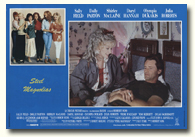
I'm including a movie clip that shows a great scene from the
film with Dolly as the vivacious hairdresser named Truvy who runs a home-based
beauty salon and Sam in the role of her husband Spud,
described as a quiet, moody man. They're preparing to attend the funeral of
their friend Shelby.
Here's the
link.
As in many films, Sam became a recognizable figure in America
cinema, often portraying the font of mature and untamed masculine sexuality.
Here's a movie still from the film:
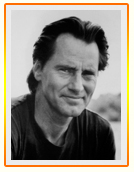
Perhaps the most intriguing criticism of the film dealt with
whether it did or didn’t have a man problem. Movie critic Hal Erickson wrote,
"The film stumbles a bit in its depiction of the male characters as fools and
deadheads." Both Hal Lipper of the St. Petersburg Times and New York Times
reviewer Vincent Canby lamented the film’s decision to have actors play the
leading ladies’ husbands, sons, and boyfriends onscreen at all. In the stage
show, the male characters only existed offstage. Roger Ebert noted that the men
"do not amount to much in this movie" but concluded it was "a woman's picture".
He added, "I doubt if any six real women
could be funny and sarcastic so consistently but I love the way these women
talk, especially when Parton observes: ‘What separates us from the animals is
our ability to accessorize.'” |
|
|
|
March 30, 2020 |
|
I recently came across another book on Sam called "Rebelul
Rigorii Mortale", by Romanian writer Alexandra Ares. It was originally
published in 2004 but then later expanded in a 2018 edition by Aldine Publishing
House. The title translates to "A Rebel of Rigoris Mortis". It won the award for
the best drama book from the Union of Writers in Bucharest.
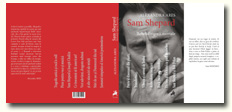
Here is a quote from her book:
"Intuitive and prolific writer, Shepard has improvised
theater replicas just as jazzmen improvise musical lines, but he was brilliant
in these insights. He rewrote very little, astonishing his friends. The former
colleague from the Lower East Side room told how Sam bought a box of paper, went
into the room, started beating the car and came out a few hours later with a new
piece. […] Shepard reinvented American theatrical language at a time when
innovation came from Europe, brought an influx of energy, mystery, revolt and
magic into American drama so deeply realistic and created a mythology of the
present, starting from the idea. that 'the old God is too far' and 'no longer
represents our suffering.' ...Alexandra Ares
* * * * *
 The movie page for DEFENSELESS
(1991),
has been added today. Besides Sam, it starred Barbara Hershey, J.T. Walsh and
Mary Beth Hurt and was directed by Martin Campbell. I'd like to write some
positive comments but truth be told, the film was a flop. According to Jonathan
Rosenbaum of Chicago Reader, it was "a watchable but instantly
forgettable mystery thriller... Sam Shepard does his usual poker-faced bit as
the police detective assigned to catch the killer." Ouch! And from another
critic, "As a homicide detective named Beutel, Sam Shepard is the only low-key
player in the ensemble, so lanky and laconic you could picture him splitting
rails in his spare time." And Candice Russell of the Sun-Sentinel writes,
"Merely mediocre, Shepard chews gum and looks half-interested, perhaps because
he'd rather be riding horses than making movies." Yowser! Okay, you're catching
on. The movie page for DEFENSELESS
(1991),
has been added today. Besides Sam, it starred Barbara Hershey, J.T. Walsh and
Mary Beth Hurt and was directed by Martin Campbell. I'd like to write some
positive comments but truth be told, the film was a flop. According to Jonathan
Rosenbaum of Chicago Reader, it was "a watchable but instantly
forgettable mystery thriller... Sam Shepard does his usual poker-faced bit as
the police detective assigned to catch the killer." Ouch! And from another
critic, "As a homicide detective named Beutel, Sam Shepard is the only low-key
player in the ensemble, so lanky and laconic you could picture him splitting
rails in his spare time." And Candice Russell of the Sun-Sentinel writes,
"Merely mediocre, Shepard chews gum and looks half-interested, perhaps because
he'd rather be riding horses than making movies." Yowser! Okay, you're catching
on.
I didn't come across any production notes or interesting
stories, but the following excerpt is from a letter from Sam written in Virginia to
Johnny Dark on October 3, 1989 - "I have to return to L.A. on the 14th thru the
16th of this month for a re-shoot of Defenseless. I'll be staying at the
Four Seasons Hotel on Doheny - if you want to give me a call down there. I
really don't want to leave the farm now that Fall has arrived but I guess I have
to go. It would be great to see you if you happen to find yourself in L.A.
around then."
I will say that the best thing to come out of this film is
this photo which I used on the home page. It actually looks like a movie still
from "The Right Stuff". Handsome pic!
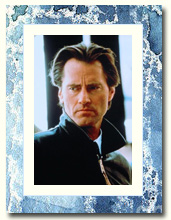
|
|
|
|
March 27, 2020 |
|
I've added the play page for 1994's SIMPATICO.
It was Sam's first full-length play in ten years and was originally targeted for
Broadway with a cast that included Ed Harris, Jennifer Jason Leigh, Frederick
Forrest and Beverly D'Angelo. However, the $800,000 production budget couldn't
be met or as Sam put it, "the deep pockets didn't present themselves". Plans
were then made to stage it at the Off Broadway Public Theater. Sam directed with
Ed Harris and Beverly D'Angelo remaining with new cast members Fred Ward, Marcia
Gay Harden and James Gammon.
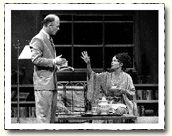
The story took place in the world of thoroughbred horse racing with Sam
describing it as being "about the rivalry between two close friends who have
known each other their whole lives, and involves women and horses, gambling,
deceit, envy, jealousy, rage: the stuff I can't help writing about."
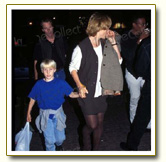
Sam with Lange and
son Walker at the "Simpatico" preview show on November 5, 1994 at the Joseph
Papp Theatre.
"Simpatico"
received generally favorable reviews. Vincent Canby of the New York Times
called it one of the best plays of the year, and it sold out its initial run but
did not hold enough promise to move to Broadway. Five years later, it was
adapted for the screen with Nick Nolte, Jeff Bridges, Sharon Stone, Catherine
Keener and Albert Finney. Matthew Watchus directed and wrote the screenplay but
it was a struggle adapting it. One critic wrote, "Where the play is
stripped to bare essentials, the film invokes flashbacks to fill in the
backstory, adds multiple locations, and introduces other diversions that slowly
strangle the subtle points Shepard achieves in his original."
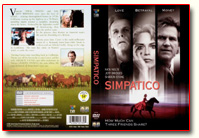
Certainly, we know that Sam had firsthand knowledge here as far as horses. Hotwalker, rodeo rider, farm manager, team roper, polo
player and foxhunting and cutting horses - there's wasn't much that Sam hadn't
done with horses. Then in 1987, he became a Thoroughbred breeder. He recalled,
"I had a farm, and I'd never been able to afford Thoroughbreds. But I've always
been fascinated by pedigrees, by how you plan and actually breed these things.
Now I had the chance." In a 2007 interview, he said, "I plan all the matings and never talk to
bloodstock agents. I spend endless hours poring over pedigrees, but some of the
best horses I've bred came from instinct."
Forever the cowboy, both on and off screen, Sam was often photographed in his
western gear. This new photo on the right, which was taken in 2005, is from the
National Portrait Galley of the Smithsonian Institution, a gift from Bill and
Sally Wittliff. The photographer is Matt Lankes, who also took the first photo,
which was previously posted and featured in the April 2006 issue of Cowboys &
Indians.
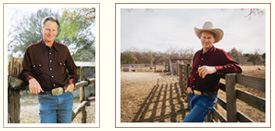
Previously I have posted this famous Annie Leibovitz photo, but always in black
and white. This is the original color photo from the December 1984 issue of
Vanity Fair.
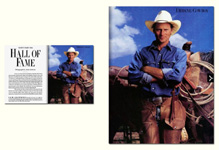
|
|
|
|
March 23, 2020 |
|
In these coronavirus times of being housebound, I've begun
adding missing film pages to several of my web sites. Today I give you
FRANCES, the film that introduced Sam to an
actress called Jessica Lange, who birthed two of his three children.
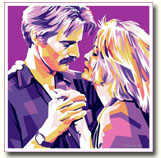
The 1982 biopic chronicles the life of actress Frances Farmer
from the 1930s to the 1950s beginning with her high school days as a rebellious
student in Seattle. She wrote an essay questioning God, which outraged folks as
well as her visit to Moscow. The publicity plus her talent led to a successful
Broadway and Hollywood career, followed by a mental breakdown and many years in
mental institutions. Her domineering mother, outstandingly portrayed by Kim
Stanley, was instrumental in creating instability and dysfunction in her
daughter's life.
Sam plays Harry York,
a fictional person based on a political radical named Stewart Jacobson who
claimed to have been one of Farmer's lovers, though close friends of the star
denied his even knowing her. Just how a movie can claim to be historically
accurate when the protagonist's main love interest was an invention by the
writers is a question the filmmakers never address, although on the DVD
commentary director Graeme Clifford states, "We didn't want to nickel and dime
people to death with facts." He also went on to remark that Lange hadn’t had to
"act" for the role in Frances. "She just let out all the stuff she
usually represses." My sentiments exactly. When you look at this photo of
Frances Farmer, you can see a strong resemblance to Lange.
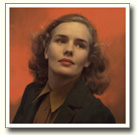
The film opened to mixed reviews with complaints focused on
the story's
inaccuracies, such as the fictionalized lobotomy and the above mentioned
Harry York. In his review, Roger Ebert writes, "There are a few problems with
the film's structure, most of them centering around an incompletely explained
friend of Farmer's, played by Sam Shepard as a guy who seems to drift into her
life whenever the plot requires him." As to my own reaction, I kept questioning
their strange relationship.
Interesting that several actresses were considered for the
lead role including Jane Fonda, Sally Field, Natalie Wood, Susan Sarandon and
Meryl Streep. Though Lange received an Academy Award nomination for Best
Actress, it was Meryl Streep who swept up that Oscar for her role in "Sophie's
Choice". But all was not lost because Lange's role in "Tootsie" garnered her an Oscar
for Best Supporting Actress, often referred to as her consolation prize.
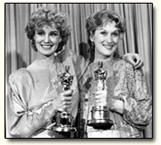
Personally, I thought the most pleasurable offering from the
film (besides the onscreen presence of Sam) was its soundtrack by John Barry.
The music is about as hauntingly beautiful as any ever written by this talented
composer. You can listen to the soundtrack
at this
link.
* * * * *

As reported on January 29, a limited edition of "Sam
Shepard: New Mexico" was released this month by Lawless Media. The 105-page
book, priced at $75, is a quirky ode to Sam by Galisteo publisher John Miller.
The limited-edition book gathers starkly powerful (meandering and sorrowful,
funny, frank and intimate) passages from Sam's work with a focus on those that
touch on the Land of Enchantment, where he lived off and on beginning in the
1980s. This special volume pairs Sam's writings with acclaimed artist Ed Ruscha
during their separate times in New Mexico. You can read an excerpt called "Pink
Adobe". |
|
|
|
February 1, 2020 |
|
I used to live and work in Boston so I'm always connected to
the city's cultural events. The Boston Museum of Fine Arts will be screening
DAYS OF HEAVEN on February 28 and 29 in the
Harry and Mildred Remis Auditorium. The museum describes it as "a celebrated
example of the power of subtlety. Malick’s painterly use of light and atmosphere
has moved critics throughout the decades to describe Days of Heaven as
one of the most beautiful films ever made." I ask you who can't help but fall in
love with the looks of this rich and stoically handsome, but nameless farmer.
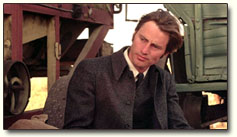
Jean-Claude van Itallie, playwright, performer, and teacher,
once said, "Many of us Greenwich Village playwrights were gay. Sam was
flamboyantly, abundantly straight. His ebullient sexuality was charismatic—you
could see it sparkling in his eyes, and it later helped make him a movie star.
Ellen Stewart, La MaMa herself, the living, beating heart of Off-Off-Broadway,
once remarked that Sam was like 'juicy Lucy,' as Ellen called the erotic urge,
flowing plentifully and creatively."
* * * * *
Here are a couple new photos of Sam at the Abbey Theatre in
Dublin meeting with young playwrights back in 2009.
* * * * *
Magic Theatre founder John Lion wrote a 1984 article
for American Theatre in which he gave some background on the poster and book
cover for Fool for Love featuring Elvis. Apparently, the famous candid
photo was taken on June 30, 1956 in Richmond, VA by Alfred Wertheimer. Lion
describes the photo - "On a glossy background and filling the cover page, in a
dark jacket and perfectly coiffed conk, was Elvis Presley in an early ’56 photo.
Tight in on him, nose to nose, her bare shoulder slightly pressed forward in
anticipation, with a slightly skewed bouffant and a diamond broach earring, was
a beautiful unidentified blond. And what was joining the two figures, in the
space between their faces, catching a little light and subtly glistening? Why,
their tongues!"
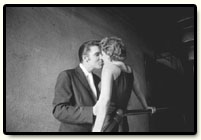
"Believe it or not, when the show went from Magic Theatre to
Circle Repertory Company in New York, and the image was again used on the
poster, several shops refused to sell it, although The New York Times had no
problem printing the image."
Lion continues, "Elvis Presley and Sam Shepard signify a
change in the structure of American society that cuts much deeper than critical
catch phrases like 'the birth of rock and roll' or the 'death of the American
West.' To both Presley and Shepard is attached the idea of 'the noble savage.'
They both apparently came from nowhere, reached the top of their professions
with no formal training, rapidly became the stuff of popular myth. But beneath
each persona lies an objective, calculating artist who has basically altered the
way we look at things." |
|
|
|
January 29, 2020 |
|
Lawless Media of Galisteo, New Mexico has announced the
upcoming publication of a new book by John Miller on Sam and artist Ed Ruscha.
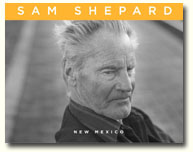
The synopsis reads:
In 1963, artist Ed Ruscha photographed filling stations
from Oklahoma to LA. He published them in Twentysix Gasoline Stations,
generally considered the first modern artist's book.
Ruscha took 60 photographs which he edited to 26. The unpublished images
from New Mexico are reproduced here, from the artist's original negatives.
Sam Shepard, Pulitzer Prize-winning playwright, author, screenwriter, actor,
and director had a deep bond with Santa Fe, where he lived in the 1980s and
from 2010-2015.
But Shepard had some nomad in him, and beginning with Motel Chronicles in
1982, he spent much time crisscrossing the deserts of New Mexico.
As Johnny Dark said: "He lived in Santa Fe, but he also lived in hotels and
on the road... He might have been running away or he might have been running
toward something."
Twenty years earlier, traveling from Oklahoma to LA, the artist Ed Ruscha
traversed the same territory, creating ghostly images of New Mexico gas
stations.
Now, in this special volume, these two restless storytellers combine their
talents to paint a unique portrait of New Mexico.
The description does not mention the number of pages nor the
size of the book, but it appears to be more of a coffee table book with black
and white photos by Ruscha and quotes from Sam's writings about New Mexico.
A sample is given from Sam's "Motel Chronicles":
In Santa Fe they stopped long enough to gas up
and then headed north toward Chimayo.
The sweet smell of juniper blew through the open
windows.
Crows floated above the highway scanning for dead
lizards and rabbits.
The Black Mesa appeared on their left and they all
agreed that they understood why the Indians
considered it sacred.
But none of them actually explained why they thought
that.
|
|
The event date for the book is listed as Saturday, March
14, 2020 at 3:00 pm at Bookworks, 4022 Rio Grande Blvd NW in Albuquerque,
NM.
|
|
|
|
January 12, 2020 |
|
Netflix documentary IT TAKES A LUNATIC profiles Wynn
Handman, who’s hailed as "the keystone of American theatre." He founded the
highly influential American Place Theatre in New York City, directing a number
of plays and he taught acting classes for more than 50 years. His former
students such as Richard Gere, James Caan, Michael Douglas, and Frank Langella
reflect on his influence on their careers as well as the theater community
through his desire to give opportunities to upcoming talent. You'll also spot
Sam Shepard in this film, which is currently available thru Netflix. Shepard
productions in the American Place's early years included 1967's "La
Turista," and
"Killer's Head".
* * * * *
And speaking of "Killer's Head", the play has been announced
in an upcoming double bill by Odyssey Theatre Ensemble in Los Angeles. The
second half is his 1969 one-act "The Unseen Hand"
- that is part of the Odyssey's 50th Anniversary "Circa '69" Season of
significant and adventurous plays that premiered around the time of the
company's inception. Check for dates running from January 25 thru March 8 at the
theatre web site.
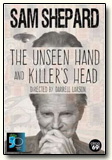 |
|
|
|
|
|
|
|
|
|
|
|